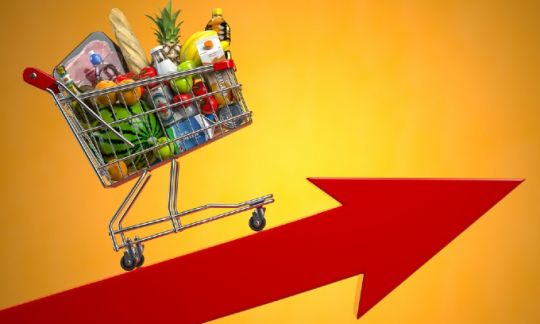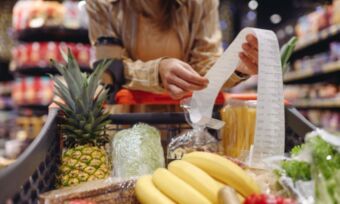How does Australia’s inflation rate compare with other countries?

Annual inflation has hit 6.1% in Australia. We look at how it compares with other countries around the world. Plus, find out what grocery products experienced the biggest price rises.
It’s official – Australia’s inflation rate has hit a 21-year high. The Consumer Price Index (CPI) rose by 1.8% in the June quarter to reach an annual rate of inflation of 6.1%, according to figures released today by the Australian Bureau of Statistics (ABS). And, it’s likely to keep rising with the Reserve Bank predicting inflation will peak at around 7% in the December quarter.
According to the ABS, the most significant contributors to the rise were new dwellings and automotive fuel. The price of new dwellings increased by 5.6% over the quarter and 20.3% over the year.
“Shortages of building supplies and labour, high freight costs and ongoing high levels of construction activity continued to contribute to price rises for newly built dwellings,” explained Head of Prices Statistics at the ABS, Michelle Marquardt. “Fewer grant payments made this quarter from the Federal Government’s HomeBuilder program and similar state-based housing construction programs also contributed to the rise.”
The fact that fuel prices increased by 4.2% over the quarter and 32.1% over the year probably comes as no shock to anyone who has filled up their tank at the bowser in the past 12 months. The average unleaded fuel price in the month of June surpassed the previous record high monthly average seen in March, according to the ABS.
The latest inflation outcome is a classic case of supply and demand where there is still mounting pressures on both sides. There is still a war happening in Ukraine, natural disasters continue to decimate livelihoods and infrastructure, and there are massive flow-throughs to supply chains.
With inflation remaining high it goes to show the last three rate rises have had no impact on price hikes. Interest rate rises will go some way towards curbing demand but they are not an effective tool when it comes to supply issues. There is going to be more pain before we see gains on the supply side that will ease costs.
So what is this likely to mean for interest rates? Given the inflation figures for June are in line with forecasts we may not see the Reserve Bank increase the cash rate as aggressively as other economies have. That said, I think mortgage holders should still brace themselves for a 0.50% hike in August.
What grocery products have had the biggest increase in price over the past 12 months?
Even though annual inflation was 6.1%, overall there are a number of individual grocery product groups that have increased significantly more than that over the past 12 months. The price of vegetables, for example, rose by 14.6%.
Of the various types of meats, beef and veal saw the biggest price hike over the 12 months (9.4%). Lower down the list were lamb and goat (7.1%), poultry (5.9%), pork (3.9%) and fish and other seafood (3.1%).
A number of different types of drinks also made the top 10 list of the products that experienced the largest price increases. Coffee, tea and cocoa, for example, was fifth overall with a rise of 9.3%.
Products that have had the biggest price increase over the past 12 months
← Mobile/tablet users, scroll sideways to view full table →
| Product category | Percentage change from corresponding quarter of previous year |
|---|---|
| Vegetables | 14.6% |
| Oils and fats | 14.0% |
| Other cereal products | 10.4% |
| Beef and veal | 9.4% |
| Coffee, tea and cocoa | 9.3% |
| Breakfast cereals | 8.8% |
| Food additives and condiments | 8.0% |
| Non-alcoholic beverages | 7.9% |
| Waters, soft drinks and juices | 7.6% |
| Fruit and vegetables | 7.3% |
Source: ABS Consumer Price Index, Australia, June 2022.
How does Australia’s inflation rate compare with other countries?
While Australia’s inflation rate may have hit a 21-year high there are a large number of countries with inflation rates significantly higher than our 6.1%. Lebanon has the highest inflation rate of any country – a whopping 210% as of June. The high rate is perhaps no surprise given the country is in the midst of a major economic crisis and its currency has experienced huge depreciation.
Lebanon is followed by Zimbabwe (192% as of June) and Venezuela (167% as of May) and Sudan (149% as of June).
There are plenty of countries at the other end of the scale. South Sudan’s inflation rate is actually in negative territory (-4.29% as of April). Gabon’s inflation rate was 1.2% as of April while Macau is sitting at 1.32% as of June.
Then there are all the countries in between these two extremes. As you can see from the table below China is at the lower end while the USA and UK are nudging double digits.
Inflation rates in various countries
← Mobile/tablet users, scroll sideways to view full table →
| Country | Inflation Rate |
|---|---|
| Australia | 6.10% |
| New Zealand | 7.30% |
| Germany | 7.60% |
| UK | 9.40% |
| China | 2.50% |
| USA | 9.10% |
Source: Trading Economics. All rates for June 2022 reference period.
How does the cost of groceries in Australia compare with other countries?
Going to the supermarket is certainly getting more expensive but how do our prices compare to other countries? I put together a grocery basket of 11 items – rice, milk, eggs, beef, chicken, potatoes, carrots, bananas, apples, Nescafe Gold coffee and Coca Cola – to find out.
Interestingly, one dozen eggs cost more in Australia than in the other five countries we looked at. As the table shows, we’re paying about $6.40 while residents in four of the other countries can pick them up for less than $5.
At $20 a kilo on average, the cost of beef in Australia isn’t too bad when you compare it to the US where it’s almost double ($37.99).
That entire basket of goods would set Aussies back about $73.30. That’s more than it would cost in China ($46.81), UK ($46.88) and Germany ($68.64) but less than in New Zealand ($76.17) and USA ($101.08).
Cost of goods compared across a range of countries ($A)
← Mobile/tablet users, scroll sideways to view full table →
| Country | Rice 1kg | Milk 1L | Dozen Eggs | Beef 1kg | Chicken 1kg | Potatoes 1kg | Carrots 1kg | Bananas 1kg | Apple 1kg | Nescafe Gold 200g | Coca-Cola 500mL | Total |
|---|---|---|---|---|---|---|---|---|---|---|---|---|
| Australia | $2.00 | $2.15 | $6.40 | $20.00 | $6.50 | $3.50 | $2.00 | $2.50 | $4.50 | $20.00 | $3.75 | $73.30 |
| New Zealand | $1.97 | $2.39 | $5.75 | $22.49 | $8.09 | $2.69 | $2.69 | $3.14 | $4.49 | $18.88 | $3.59 | $76.17 |
| Germany | $2.00 | $2.62 | $2.98 | $23.51 | $11.01 | $1.00 | $1.75 | $2.93 | $3.95 | $15.13 | $1.76 | $68.64 |
| UK | $2.08 | $2.16 | $3.03 | $16.44 | $4.05 | $0.62 | $0.69 | $1.26 | $3.32 | $10.38 | $2.85 | $46.88 |
| China | $1.67 | $2.08 | $2.51 | $13.86 | $7.62 | $3.34 | $0.71 | $1.08 | $0.84 | $12.33 | $0.77 | $46.81 |
| USA | $5.21 | $2.78 | $4.78 | $37.99 | $11.06 | $2.79 | $3.11 | $1.64 | $4.81 | $25.89 | $1.02 | $101.08 |
Prepared by www.canstar.com.au – 22/07/2022. Price of goods sourced from globalproductprices.com. Price of goods sampled across a range of dates depending on the product type, and represents the latest available pricing. Milk prices are for semi-skim milk with fat content between 1.5% and 2.5%, depending on the specifics of each country. Pricing sampled based on the most popular brands in each country.
Based on those numbers, you might be thinking China has it pretty good as they are paying $26 less than us for the same basket of goods. Things don’t look quite as rosy, though, when you look at how much it costs them as a percentage of their daily income.
That $46.81 equates to more than three-quarters of their daily income. So, although China might pay the least overall for these items it actually works out to be the most expensive for them when you take into account the chunk it takes from their earnings.
It’s not as bad for us Aussies as $73.30 is about 38.71% of our daily income. It’s equivalent to a similar percentage for people in Germany (34.08%) and the UK (31.65%).
Cost of goods compared across a range of countries as a percentage of daily income
← Mobile/tablet users, scroll sideways to view full table →
| Country | Annual Income ($A) | Rice 1kg | Milk 1L | Dozen Eggs | Beef 1kg | Chicken 1kg | Potatoes 1kg | Carrots 1kg | Bananas 1kg | Apple 1kg | Nescafe Gold 200g | Coca-Cola 500mL | Total |
|---|---|---|---|---|---|---|---|---|---|---|---|---|---|
| Australia | $69,108 | 1.06% | 1.14% | 3.38% | 10.56% | 3.43% | 1.85% | 1.06% | 1.32% | 2.38% | 10.56% | 1.98% | 38.71% |
| New Zealand | $61,057 | 1.18% | 1.43% | 3.44% | 13.44% | 4.84% | 1.61% | 1.61% | 1.88% | 2.68% | 11.29% | 2.15% | 45.53% |
| Germany | $73,524 | 0.99% | 1.30% | 1.48% | 11.67% | 5.47% | 0.50% | 0.87% | 1.45% | 1.96% | 7.51% | 0.87% | 34.08% |
| UK | $54,066 | 1.40% | 1.46% | 2.05% | 11.10% | 2.73% | 0.42% | 0.47% | 0.85% | 2.24% | 7.01% | 1.92% | 31.65% |
| China | $22,436 | 2.72% | 3.38% | 4.08% | 22.55% | 12.40% | 5.43% | 1.16% | 1.76% | 1.37% | 20.06% | 1.25% | 76.15% |
| USA | $70,913 | 2.68% | 1.43% | 2.46% | 19.55% | 5.69% | 1.44% | 1.60% | 0.84% | 2.48% | 13.33% | 0.53% | 52.03% |
Prepared by www.canstar.com.au – 22/07/2022. Price of goods sourced from globalproductprices.com. Income calculated based on statistics published by tradingeconomics.com with income calculated as of Dec-2021 for Australia, China and Germany, Mar-2022 for New Zealand, May-2022 for UK and Jun-2022 for USA. Prices and incomes based on each country’s native currency which was then converted into Australian Dollars based on current conversion rates.
Cover image source: Maxx-Studio/Shutterstock.com
This article was reviewed by our Editorial Campaigns Manager Maria Bekiaris before it was updated, as part of our fact-checking process.





